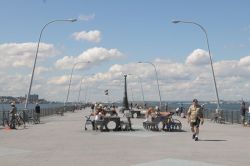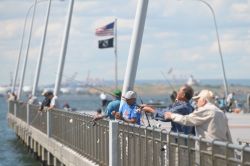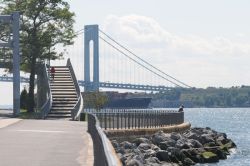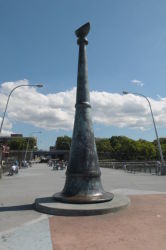Shore Park and Parkway
Vinland Playground
Shore Road Park
What was here before?
Southern Brooklyn was originally inhabited by the Canarsee. In 1761, Harmanus Barkeloo, one of the largest landowners in New Utrecht, conveyed the property between present-day Third Avenue and the harbor between 94th and 97th Streets to his new son-in-law John Bennett (descendent of Willem Adriaense Bennet, the first European settler of the Gowanus area). Bennett’s heirs subdivided the northern half of the property and in the nineteenth century, this property was owned by Hawley D. Clapp. He operated Hamilton House, a mansion turned resort before it burned down in 1853. Clapp was later accused of defrauding military recruits of their bounties during the Civil War.
How did this site become a playground?
Shore Road Park was acquired by the city in several parcels starting in 1897. This playground was built in conjunction with the Belt Parkway. Developed in 1924, the thoroughfare was part of Robert Moses’s vision to increase automobile access to the five boroughs. He considered Shore Parkway and the rest of the Belt Parkway a “continuous park system, not merely an automobile artery, a system of shoestring parks and recreational facilities encircling the entire metropolis…” The playground was one of five opened to the public in 1942 when the Works Progress Administration finished most of the park development. The playground included swings, a wading pool, and a skating rink.
In 1982 Parks replaced the rink and pool with a baseball field and lawn and installed new wood play equipment. In 1999, the equipment was updated with steel features. In 2024 the playground was reconstructed with new play structures, seating, a spray shower, and plantings.
Who is this playground named for?
In the 1990s, the playground was named to honor Bay Ridge’s rich Norse heritage. The name commemorates the first discovery of America by Norse explorer Leif Erikson (c.960-c.1020) and his subsequent naming of the continent as Vinland. Ericson was probably the first European to set foot on the American continent, nearly 500 years before Christopher Columbus's (1451-1505) voyages.
En route to Greenland, his longboat was blown off-course by a severe storm. Arriving on the northeastern coast of the North American continent a few weeks later, Ericson deduced he made a navigational error and returned to Greenland. A short time later, the explorer returned to what he called Vinland, named for the abundance of grapes. However, attacks by the Indigenous population, harsh winter weather, and low food supplies convinced him to return to Greenland in 1001.
Check out your park's Vital Signs
Clean & Safe
Green & Resilient
Empowered & Engaged Users
Share your feedback or learn more about how this park is part of a
Vital Park System










